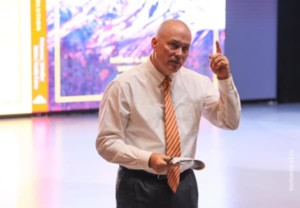The Time to Change is Now

By: Jena Draper
Learning is inefficient. There, I said it. This situation is a classic case of “It’s not me, it’s you”, where in this specific instance it is not you [teachers], it is the system. It’s a problem you face every single day when the bell rings and you have things that were left untaught. It’s the cause of the disparity felt when performance is down, and you did everything you could and it wasn’t enough. It’s a pain your students feel that they are afraid to voice. But, it was a pain I felt as a student that was too great to ignore. It’s a pain I traded my MBA and fast track to consulting to bring into the spotlight and give a voice.
There are a few big problems or opportunities that consistently get brought up in regards to teaching and learning. I imagine the words “Disengaged Learners” are quite familiar in your school. It is continually said that social media has been the cause for students being disengaged. But, let’s be honest, this problem started long before Zuckerburg.
As a student, I heard these same words muttered by my teachers and administrators; and it was well before Facebook’s 2004 go-live date. This was during the time where you could not be on the Internet and the phone at the same time, and the days where AIM away messages were today’s equivalent of a status update. It’s almost unfathomable that what my teenage siblings call “Primitive” technology was just 15 years ago.
As a Gen Y student, I have seen the digital revolution (and digital divide) happen first hand. From the colored Macintosh computer labs and Oregon Trail to BYOD and 1:1 initiatives, the learning environment has vastly changed in a relatively short amount of time. Some schools are doing away with paper and transitioning to e-books; while some of the most progressive schools are looking for ways to transition away from traditional materials all together. I sincerely applaud the latter because that means they get it!
The fact is, today’s students learn incredibly different than the way classrooms were originally designed, books were written, or even how teachers were trained to teach. Think about how you personally consume information. Whether it’s a tweet, a post, or a push notification from our favorite sources, we are incredibly tuned in to the world around us. For better or for worse, we receive and consume information as quickly as the world changes. Could you imagine going back to a world pre- Wiki where your information was 5-10 years irrelevant? That is what your students face every day with traditional material.
We live in a world where information is not only instantly exchanged, but also bite-size and able to be shared in 140 characters. The information we have come to know and love is clickable, digestible, and interactive. When was the last time you sat down and read an article that did not have at least one picture and was longer than a page? I know that I will read 50 short articles before I read an article that has a “Next page” option. In the digital world, less is more, and we have come to prefer concise messages to lengthy sources. This is an especially true story for your students.
“Have a question? Use Google to find the answer” has become the cornerstone of how we learn. Teachers no longer need to be content deliverers. Instead, educators’ skills and expertise can be utilized in leadership roles and could act as knowledge facilitators and learning coaches. However, only a handful of classrooms currently utilize online resources to their full capacities.
More than likely I am not saying anything you do not already know or share a frustration towards. Your administrators likely know learning is inefficient, but are unsure how to change an age-old classroom model into a next generation learning opportunity. No one knows when this paradoxical shift for education will happen. New Media Consortium’s 2014 K-12 Horizon Report makes valid predictions on what is to come. What we can all agree on is that no one wants to be left behind.
What Would Efficient Learning Look Like?
Efficient learning would look very different than the current learning environment. Classrooms would utilize and go beyond blended learning models to diversify instruction. Lectures and textbooks would be supplemented or replaced with active and self-directed learning environments. Assessment would be competency based, and include the 4 P’s of next gen learning. The existing “fluff” would be replaced with concise, direct messages, leaving more time for deeper learning and instruction. Above all, efficient learning would result better learning and better use of the limited and precious classroom time.
Teachers, it is not you, it’s the system; and it’s time to call for a change.
Jena Draper is the co-founder and CEO of the Dallas education startup, Navvie (@therealnavvie). Jena is a recent graduate who is passionate about leveraging the pain she experienced in school to transform learning to meet the needs of tomorrow’s students. Her perspective, as both a recent graduate and entrepreneur, offers education technology a much needed student’s perspective.







0 Comments
Leave a Comment
Your email address will not be published. All fields are required.